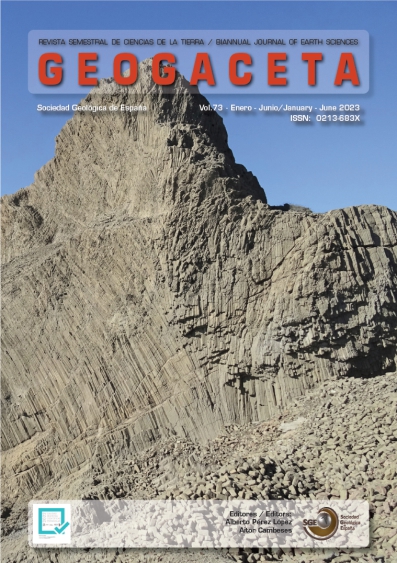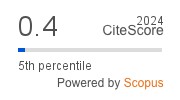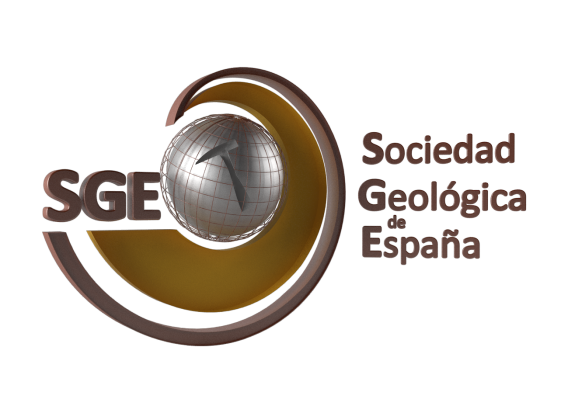Aplicación de métodos hidrogeoquímicos y geotermométricos al estudio del potencial geotérmico del sur de Tenerife
DOI:
https://doi.org/10.55407/geogaceta95147Palabras clave:
Tenerife, hidrogeoquímica, geotermómetro, calcedoniaResumen
El presente trabajo trata de poner en contexto el área sur de la isla de Tenerife, un terreno con alto potencial geotérmico. Se realiza un análisis hidrogequímico de las aguas subterráneas del entorno, utilizando para ellos métodos de análisis geoquímico como los diagramas de Piper, Giggenbach, y Log (K² /Ca) vs. Log (K² /Mg). Se define un carácter bicarbonatado-sodico para las aguas y se observa un avance diferencial en la trayectoria de madurez de estas. Por último, se aplica el geotermómetro de la sílice, en concreto el del polimorfo de la calcedonia, para estimar las temperaturas a las que podría encontrarse el acuífero en profundidad. Finalmente, se indican aquellos factores que podrían inducir a error y se recomiendan aquellos estudios que podrían solventarlo.
Citas
Anguita, F., y Hernán, F. (2000). The Canary Islands origin: a unifying model. Journal of Volcanology and Geothermal Research, 103(1-4), 1-26. https://doi.org/10.1016/S0377-0273(00)00195-5
Armorsson, S., Gunnlaugsson, E., y Svavarsson, H. (1983). The chemistry of geothermal waters in Iceland. III. Chemical geothermometry in geothermal investigations. Geochimica et Cosmochimica Acta, 47(3), 567-577. https://doi.org/10.1016/0016-7037(83)90278-8
Carracedo, J. C., y Troll, V. R. (2016). The geology of the Canary Islands, 636 p.
Carracedo, J. C., Badiola, E. R., Guillou, H., Paterne, M., Scaillet, S., Torrado, F. P., ... y Hansen, A. (2007). Eruptive and structural history of Teide Volcano and rift zones of Tenerife, Canary Islands. Geological Society of America Bulletin, 119 (9-10), 1027-1051.
Consejo Insular de Aguas de Tenerife (2018). Plan Hidrológico de Tenerife. Demarcación Hidrográfica ES124 Tenerife. Ciclo de planificación Hidrológica 2015-2021. B26087.1
Fournier, R. O. (1977). Chemical geothermometers and mixing models for geothermal systems. Geothermics 5(1-4), 41-50. https://doi.org/10.1016/0375-6505(77)90007-4
Geyer, A. y Martí, J. (2010). The distribution of basaltic volcanism on Tenerife, Canary Islands: Implications on the origin and dynamics of the rift systems. Tectonophysics 483(3-4), 310-326. https://doi.org/10.1016/j.tecto.2009.11.002
Giggenbach W.F. (1988): Geothermal solute equilibria. Geochimica. Cosmochim. Acta 52, 2749 - 2765. https://doi.org/10.1016/0016-7037(88)90143-3
Karingithi, C. W. (2009). Chemical geothermometers for geothermal exploration. Short Course IV on Exploration for Geothermal Resources, 1-22
Marrero Díaz, R. (2010). Modelo hidrogeoquímico del acuífero de las cañadas del Teide, Tenerife, Islas Canarias. Universitat Politècnica de Catalunya. Tesis Doctoral.
Moreno, L., y De la Losa, A. (2008). INAQUAS: Utilidad para la interpretación de análisis químicos de aguas subterráneas. Publicaciones del Instituto Geológico y Minero de España, Madrid, 1-28.
Descargas
Publicado
Cómo citar
Número
Sección
Licencia
Hasta el año 2023 el autor/a cedía el copyright (“derechos de autor”) a la Sociedad Geológica de España, pero desde el 2024 el/la autor/a conserva los derechos de autor y concede a la Sociedad Geológica de España el derecho de la primera publicación y de manera no exclusiva cede la distribución de cada artículo en todos los soportes actuales o futuros, al mismo tiempo que ceden, también de manera no exclusiva, los derechos comerciales para la distribución de la versión impresa de Geogaceta. Por otra parte, los artículos, a partir del año 2023, están disponibles simultáneamente a su publicación, bajo la licencia Creative Commons CC BY-NC-SA 4.0, que permite copiar, transformar el trabajo, pero si se distribuye transformándolo, el nuevo trabajo debe distribuirse bajo la misma licencia, y nunca con propósitos comerciales, al tiempo que se reconoce la autoría y la publicación original en GEOGACETA, de tal manera que el único rol del copyright es dar a los autores el control sobre la integridad de sus trabajos y el derecho de ser adecuadamente reconocidos y citados.









